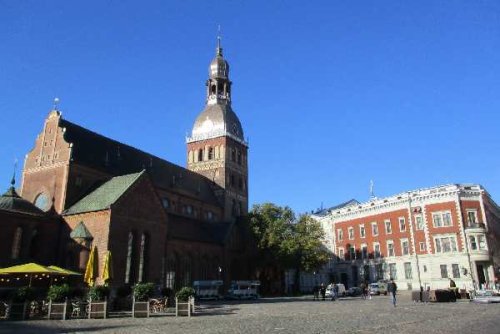"When I was young, one of my friends at school was called Ēriks. It wasn’t a typical Yorkshire name. His family was Latvian. The parents had left Latvia in 1940 and there was quite a large Latvian community in our town. Every weekend, he went to the Latvian school to learn the language and the traditions of his country. So since my childhood, Latvia was always present through Ēriks, at a time when many people in the West were unaware of the existence of this country, which had been absorbed into the Soviet Union.
Latvia is bordered by Estonia to the north, Russia to the east, Belarus in the south-east and Lithuania in the south. But these borders are quite recent and Latvia is made up of four provinces – Vidzeme, Latgale, Zemgale and Kurzeme – each of which has their own history.

The long river Daugava, with its source in the Russian marshes near to Smolensk, flows into the sea at what is now Riga. From the earliest times, it became a communication route for commerce. The tribes which came to make up the Latvians arrived in the area around 3,000 years BCE.
Only towards the end of the 12th century were the first Christian missionaries sent to these regions. In 1184, St Meinhard went on the Daugava as far as Iksile. He lived there and learned the language but his mission didn’t take root. So, in 1193, Pope Celestine III launched a crusade in Northern Europe to convert the pagan tribes living there. This was the time of the Order of Livonian Knights. Christianity came from outside in the form of conquest.
The lands colonised by the Knights was inhabited by the Livs and called Livonia, but its first title was Terra Mariana – a land dedicated to Mary. It comprised what is today Latvia and Estonia.
The city of Riga was founded in 1201 and Bishop Albert laid the foundation stone of the Cathedral 10 years later. Riga became a great port of the Hanseatic League. Through this and the Livonian Order a German presence and influence began.

The major regional power at this time was Poland-Lithuania, two countries bound in alliance together. In the middle of the 16th century, the Livonian War broke out pitting the Tsardom of Russia against a coalition including Poland-Lithuania, the latter taking control of Latgale, the eastern part of today’s Latvia.
The Lutheran Reformation arrived in Riga at the end of the 16th century, above all in the German communities.
During the 17th century, there was war between Poland-Lithuania and Sweden. Sweden rose in power and at the beginning of the 17th century, most of today’s Latvia fell under the Swedish crown. Riga became the biggest city of the Swedish Empire.
Thus, from 1629, the Reformation was consolidated in Vidzeme, Zemgale and Kurzeme. Latgale remained under Polish control and evolved differently. Latgalian, a cousin of Latvian, is still spoken in the region today, which remains strongly Catholic. The Marian pilgrimage on August 15 to the little town of Aglona in Latgale draws people from all over Latvia, but also from Lithuania and Poland.
A century later, Russia began to rise in power under Peter the Great. He vanquished the king of Sweden, Charles XII, at Poltava and Vidzeme was integrated into the Russian Empire. Latgale remained a further 80 years under Polish domination before too being absorbed into the Russian Empire.
Kurzeme and Zemgale became an autonomous duchy within the Poland-Lithuania until 1795 when they were integrated into the Russian Empire, even having colonies in the Caribbean in Tobago and in Gambia, where there was a commercial trading point.
In the middle of the 19th century, the national awakenings in Europe had begun. From the time of the occupation by the Order of Livonian Knights, and even under Swedish and Russian rule, the big landowners in the Latvian lands were of German stock. The Latvian nationalist movement in the 19th century linked together with the slavophiles, of Russian stock, against the German landowners. In 1905, the first Russian revolution took place and the nationalist movement, socialist in nature, grew in strength. But this revolution faltered and the Russian Empire survived."

 TAIZÉ
TAIZÉ